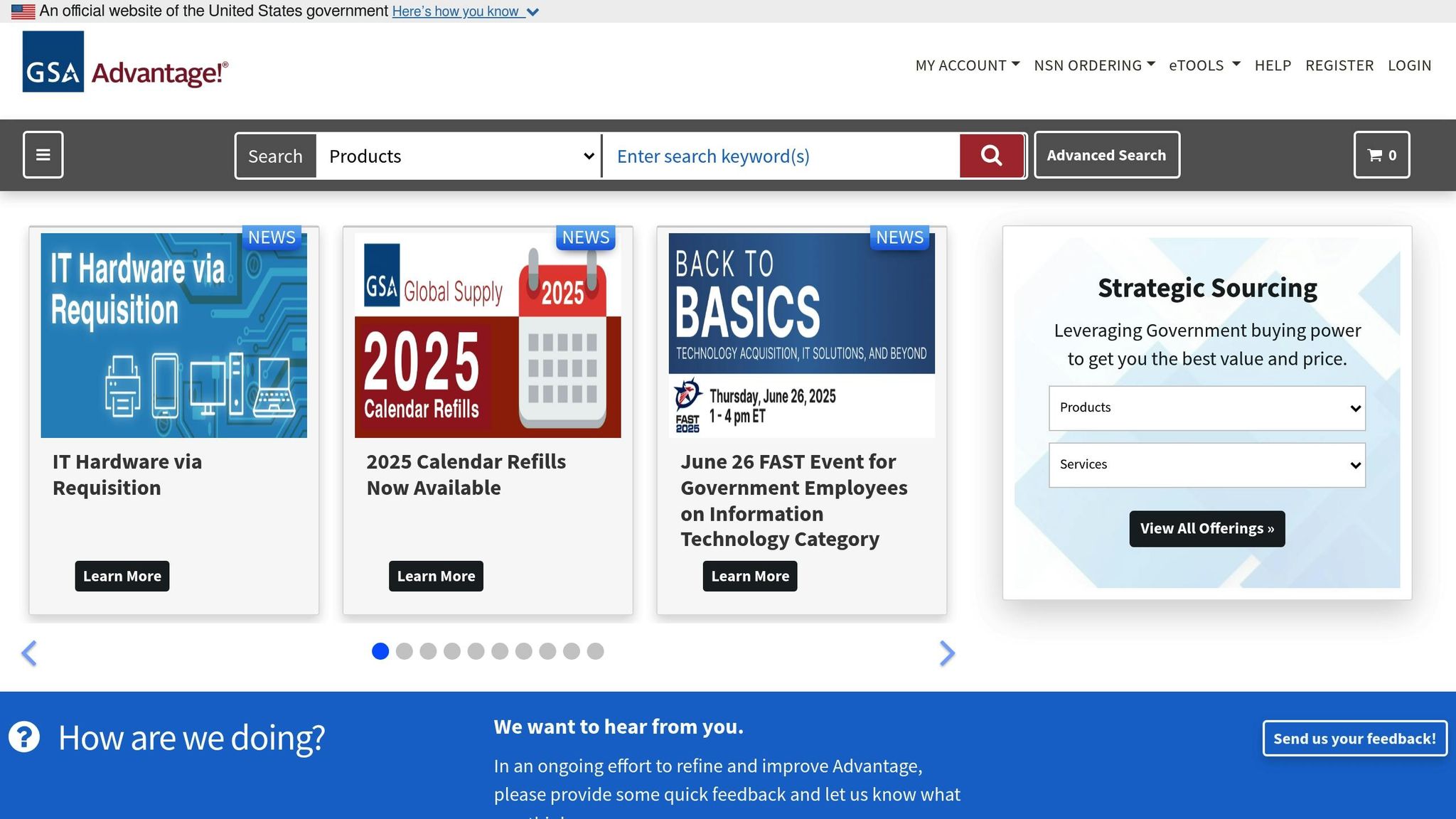GSA Advantage is the federal government’s online marketplace. It connects government buyers with pre-approved vendors and simplifies procurement while offering small businesses a chance to grow through government contracts. Here’s what you need to know:
- What It Is: A platform for federal, state, and local agencies to buy products and services directly from GSA-approved vendors.
- Why It Matters: In FY2023, government buyers spent over $65 billion with GSA Schedule vendors. Small businesses can secure consistent revenue, reduce competition, and gain visibility.
- Key Benefits:
- Access to nationwide government buyers.
- Simplified ordering and compliance processes.
- Potential for repeat business with long-term contracts.
- What You’ll Need:
- A GSA Schedule contract.
- A compliant product catalog with clear details like pricing, product specs, and TAA compliance.
- Registration with SAM.gov and the GSA Vendor Support Center.
Pro Tip: Optimize your product listings with precise keywords and high-quality images to stand out and attract buyers.
If you’re ready to tap into a $600 billion federal market, GSA Advantage is your gateway. Keep reading for step-by-step guidance on setting up your listings, managing compliance, and growing your government sales.
Benefits of Selling on GSA Advantage

Access to Government Buyers Nationwide
GSA Advantage connects your products to a vast network of verified federal, state, and local buyers through established purchasing programs. In FY2023 alone, government buyers spent over $65 billion with GSA Schedule vendors – a 14% jump from the previous year – with the broader federal market hitting an impressive $649 billion.
This platform ensures your products are visible to buyers actively searching for solutions, often with allocated budgets in hand. Unlike private sector sales, which can involve lengthy lead-nurturing processes, government buyers on GSA Advantage typically know what they need and have the purchasing authority to act quickly. This expansive reach and efficiency make the ordering process smoother and faster for sellers.
Simplified Ordering for Buyers and Sellers
One of the standout features of GSA Advantage is how it simplifies the procurement process. Government buyers can skip the usual red tape and instead browse, compare, and purchase products directly online.
The platform also supports government-issued credit card payments and provides integrated order tracking, significantly speeding up the sales cycle while reducing administrative tasks. Since all vendors on GSA Advantage have already been vetted and approved through the GSA Schedule process, buyers don’t need to conduct additional evaluations or compliance checks. This streamlined approach not only saves time but also lays the groundwork for building long-term relationships with government agencies.
Potential for Repeat Business
For small businesses, the stability provided by government contracts is invaluable. Unlike private sector clients who may frequently switch vendors, government agencies tend to stick with suppliers that consistently deliver quality and competitive pricing. GSA Schedule contracts can last up to 20 years, offering a reliable revenue stream through recurring orders.
Many agencies require the same products repeatedly – whether it’s office supplies, IT equipment, maintenance services, or specialized tools. By providing dependable service and quality products, you increase the likelihood of agencies returning to your GSA Advantage listings for future needs.
Another advantage is reduced competition. When an agency issues a bid under the GSA Schedule, only other GSA-approved vendors can compete for the contract. This is particularly beneficial for small businesses, which make up nearly 50% of GSA Schedule holders. In 2022, small businesses secured over $154 billion in federal contract dollars. Once established on GSA Advantage, you can respond to multiple requests for proposals without resubmitting the same documentation repeatedly. This efficiency allows you to chase more opportunities, build a diverse customer base, and avoid over-reliance on a single buyer.
How To Sell On GSA Advantage? – CountyOffice.org
Setting Up Your Product Listings
Creating effective product listings is key to leveraging the benefits of GSA Advantage. A well-crafted listing not only meets GSA’s requirements but also draws the attention of government buyers. After your contract is awarded, you’ll need to submit your electronic catalog within 30 days.
Required Information for Product Listings
To meet GSA standards, your product listings must include the following:
- Your contract number, manufacturer part number, and manufacturer name.
- Clear, high-quality product photos in JPG or GIF format (max size: 1MB, filenames under 80 characters). Note that generic company logos won’t meet this requirement.
- TAA compliance details and country of origin for most products.
- Comprehensive product specifications, current pricing, and availability status.
Additionally, you must provide order status updates for all GSA Advantage orders. This can be done through EDI, the Purchase Order Portal, or cXML. By including all these details, you ensure your products are not only compliant but also more likely to attract buyers.
Making Your Products Easy to Find
The GSA Advantage search engine prioritizes results based on factors like part number, product name, company name, and product description. Interestingly, 90% of buyers only view the first page of search results, with page two receiving just 5% of the attention.
To make your products stand out, use keywords that align with how government buyers search. Avoid vague marketing language and focus on precise, technical terms. For instance, if you’re selling office chairs, include specifics like "ergonomic lumbar support" or "height-adjustable armrests" rather than generic phrases such as "comfortable seating." Detailed and keyword-rich descriptions help buyers find your products more easily – especially since GSA Advantage is often referred to as the "government version of Amazon".
Once your listings are optimized, it’s crucial to manage them effectively through the appropriate catalog platform.
Uploading and Managing Your Catalog
If eligible, use the FAS Catalog Platform (FCP) to upload and manage your catalog. Otherwise, you’ll need to register with the GSA Vendor Support Center and use the SIP software for submissions.
For FCP users, start by registering with your existing FAS ID. Then, verify your Seller Profile by submitting necessary details, such as your Contract, Contractor, Dealer, and Distributor Information. Once your profile is set up, download the pre-populated Product File, complete any missing fields, and submit it. You’ll receive a Compliance & Pricing Report highlighting any issues that need to be addressed.
If you’re using SIP, register with the GSA Vendor Support Center, download the SIP software, and follow the provided instructions to upload your catalog.
For vendors using EDI, contact the EDI help desk to get your IP address, login credentials, and SFTP password. Upload your documents via SFTP, ensuring filenames include your contract number.
Regularly review your catalog data to confirm that everything displays as intended. Correct any errors, such as pricing discrepancies or missing information, as soon as possible. Keeping your listings accurate and up to date is essential for maintaining a positive reputation with government buyers.
GSA purchase orders are sent through various channels, including the GSA Purchase Order Portal, EDI, or XML. Choose the method that integrates best with your current order management system to ensure smooth processing. Proper catalog management plays a vital role in delivering on GSA Advantage’s promise of simplifying government procurement.
sbb-itb-8737801
Meeting Compliance Requirements
As a GSA vendor, staying compliant with pricing rules and fee structures is essential to avoid contract violations and maintain your GSA Advantage selling status. Here’s what you need to know.
Pricing Rules and Industrial Funding Fee
At the heart of GSA compliance is fair and reasonable pricing. Contracting Officers evaluate your pricing through market research, commercial comparisons, and transaction data to ensure it meets this standard.
The Most Favored Customer (MFC) rule requires you to offer the government pricing that is as good as – or better than – what your most favored commercial customer receives under similar terms and conditions. If you’re not comfortable disclosing your Commercial Sales Practices, you can opt into the Transactional Data Reporting (TDR) program instead.
Another key compliance factor is the Industrial Funding Fee (IFF), which applies to every GSA sale. For GSA Multiple Award Schedule contracts, the current IFF rate is 0.75% (rates may differ for VA FSS schedules). This fee helps fund the operation of the Schedule program without adding costs to taxpayers. To include the IFF in your pricing, divide your discounted price by 0.9925.
Sales reporting and IFF payments are due quarterly through the FAS Sales Reporting Portal – though TDR contracts may require monthly reporting. In 2021 alone, GSA contractors generated nearly $39 billion in revenue, contributing $293 million in IFF payments. Make sure your Multi-Factor Authentication account is active to access the portal.
To stay compliant, routinely review your pricing, monitor competitive market rates, maintain accurate discount relationships for awarded items, and meet the annual minimum of $25,000 in government sales to avoid contract termination. Alongside these steps, be prepared for periodic GSA audits to verify compliance.
Getting Ready for GSA Reviews
Consistent audit readiness is crucial for maintaining your GSA Advantage status. GSA conducts pre- and post-award audits to ensure your pricing, billing practices, and other contract terms are in order.
Before an audit, take these steps:
- Familiarize yourself with the agency’s requirements.
- Conduct an internal review to address potential issues.
- Gather all necessary documentation, including pricing records, sales data, discount agreements, and communications with GSA buyers. For service contracts, prepare resumes for comparison with GSA labor category requirements.
Designate a single point of contact for the audit, prepare your team for potential interviews, and request an entrance conference to clarify the audit’s scope and objectives.
Proper documentation is critical. A 2017 GAO audit revealed that 22% of government transactions lacked sufficient documentation to support the approval process, leading GSA to reemphasize the importance of complete records. After the audit, request an exit conference to formally close the review and confirm when the final report will be issued. Regular internal reviews and a corrective action plan can help address any compliance gaps.
Getting Started as a New Vendor
Embarking on your government sales journey involves more than just listing products. As a new vendor, you’ll need to complete several key steps – from securing a GSA Schedule contract to understanding the tools that will be essential for managing your government sales operations.
Steps to Begin Selling
The first step is obtaining a GSA Schedule contract, which acts as your gateway to the federal marketplace. This process has strict timelines, so preparation is key. Make sure to review and understand the required contract clauses.
Once your contract is in place, you’ll need to submit your catalog electronically, either through EDI or the Schedule Input Program (SIP). However, GSA is actively transitioning to the newer FAS Catalog Platform (FCP), which will eventually replace SIP.
The type of catalog you submit depends on your awarded Special Item Numbers (SINs). To determine what’s required, consult the Schedules SIN-MOL-Photo-UPC table. If your SINs require orderable products or services, you’ll need to submit a complete electronic catalog that includes all approved items along with a Terms and Conditions Price List. For SINs that don’t require orderable items, you’ll only need to submit a Terms and Conditions Price List, which should include contract terms, labor categories, and approved pricing. Be sure to include only items listed on your approved FSS Price List.
To assist with this process, GSA provides a Contractor Start-up Kit with detailed instructions to help vendors get their catalogs live on GSA Advantage.
Once your contract is secured and your catalog is live, the next step is to focus on effective catalog management.
Tools for Managing Your GSA Business
Managing your catalog efficiently is critical once it’s live. The GSA Vendor Portal serves as the central hub for handling orders, especially if you’re not using EDI systems. This web-based platform simplifies order management and offers valuable business intelligence tools.
GSA is also modernizing catalog management with the FAS Catalog Platform (FCP), which automates catalog publishing and introduces built-in templates. A standout feature of the FCP is its automatic Compliance & Pricing (C&P) report. This tool helps vendors conduct market research and spot compliance issues early.
When your contract becomes eligible for migration to the FCP, GSA will notify you. The transition involves registering at catalog.gsa.gov/register using your existing FAS ID, verifying your Seller Profile with your current contract and company details, and completing a baseline of your full catalog.
For product catalogs, you’ll download a pre-populated Product File containing your current GSA Advantage details. You’ll need to fill in any missing fields and address compliance flags identified in the C&P report. Service providers will use their last awarded Price Proposal Template to create a Services Plus File. Keep in mind that once your contract transitions to FCP, you won’t be able to submit new modifications until completing the First Steps process. Temporary Price Reductions will also remain suspended until your baseline modification is approved and published.
How GSA Focus Helps New Vendors

Navigating these steps can be overwhelming, especially for small businesses new to federal sales. That’s where GSA Focus comes in. They simplify the onboarding process by handling document preparation, ensuring compliance, and guiding you through contract negotiations – all with a high success rate and a refund guarantee.
GSA Focus provides full-service support to tackle the challenges of GSA Schedule acquisition. Their secure online platform makes it easy to upload documents and collaborate, while their experienced advisors assist with everything from understanding SIN classifications to managing FCP transitions. Beyond the contract award, their support continues to help you meet ongoing GSA requirements. For vendors feeling bogged down by the technical details, GSA Focus offers the expertise needed to streamline the process, allowing you to concentrate on growing your business while they handle the complexities of federal contracting and catalog management.
Getting Started with Government Sales Through GSA Advantage
GSA Advantage offers a gateway to a federal marketplace valued at over $84 billion in products, services, and solutions. For small businesses looking to break into government sales, this platform provides direct access to federal buyers across the country. But tapping into this opportunity requires understanding the initial steps and staying on top of ongoing requirements.
The Registration Process
To get started, you’ll need to complete a series of foundational steps. First, obtain a Unique Entity Identifier (UEI), secure your North American Industrial Classification System (NAICS) code, and verify your small business status through the Small Business Administration (SBA) website. Then, register with the System for Award Management (SAM) – an essential step since you can’t compete for contracts without it. During your SAM registration, you’ll also obtain your FAS ID. Be prepared to provide your Taxpayer ID, financial details, and NAICS codes. Keep in mind, activating your SAM registration can take up to 10 business days.
Once your registration is active, the next step is catalog submission. After your GSA Schedule contract is awarded, you’ll have 30 days to submit your catalog file in compliance with clause I-FSS-600. You’ll also need to register with the GSA Vendor Support Center using your Contract Number, SAM UEI, and authorized negotiator details.
To stand out, optimize your catalog with keyword-rich descriptions and high-quality images. This will help boost your visibility and attract federal buyers.
Staying Compliant and Competitive
Success on GSA Advantage isn’t just about getting listed – it’s about maintaining compliance and staying competitive. Vendors are required to generate at least $25,000 in government sales annually to keep their contracts active. You’ll also need to keep your SAM.gov information accurate, follow equal opportunity employment laws, and complete essential tasks like maintaining price lists and signing mass modifications.
GSA conducts monthly performance evaluations through delivery reports. If your performance falls below the minimum standards, you’ll need to submit a remediation strategy. Additionally, all products must meet the Trade Agreements Act (TAA) requirements outlined in clause 52.225-5. Regularly auditing your product sources is key to ensuring compliance.
Pricing Strategies and Catalog Modernization
Pricing is another critical factor. GSA’s “fair and reasonable pricing” standards mean you’ll need to monitor and adjust your prices regularly to stay compliant. Using price tracking tools can help you stay competitive. Strategies like temporary price reductions and monitoring competitors’ listings on GSA Advantage can also give you an edge.
As you master pricing and compliance, modernizing your catalog should be your next focus. The FAS Catalog Platform (FCP) is the future of GSA Advantage operations. When your contract becomes eligible for migration, GSA will notify you to register at catalog.gsa.gov/register using your existing FAS ID. Ensuring your current listings are accurate and complete will make this transition smoother.
For businesses looking for additional guidance, GSA Focus provides expert support to help navigate federal contracting requirements with ease.
FAQs
How can I get a GSA Schedule contract and start selling on GSA Advantage?
To begin selling on GSA Advantage, the first step is securing a GSA Schedule contract. To qualify, your business must meet specific eligibility criteria, including at least two years of operational history, financial stability, and a strong performance record.
Once you meet these requirements, the next step is submitting an offer to become a GSA Multiple Award Schedule (MAS) contractor. This process involves preparing detailed documentation, ensuring your pricing is both competitive and compliant, and sticking to government regulations like the Trade Agreements Act (TAA). To help you navigate this, GSA provides free workshops that can guide you through the application process.
After your contract is awarded, you can start listing your products on GSA Advantage. Make sure your listings are polished – include precise product descriptions, high-quality images, and compliance details like the country of origin. With your products live, you’ll gain access to federal agencies across the nation, opening the door to increased visibility and consistent sales opportunities.
How can I make my product listings stand out to government buyers on GSA Advantage?
To make your product listings stand out on GSA Advantage, focus on crafting clear, detailed, and accurate descriptions. Start with descriptive titles that include keywords government buyers are likely to use in their searches. Pair this with high-quality photos, detailed product specs, and compliance information like TAA (Trade Agreements Act) and Country of Origin, which are essential for federal procurement.
Keep your listings fresh by reviewing and updating them regularly. Highlight what sets your product apart, ensure your pricing stays competitive, and double-check that all compliance details are current. Well-maintained and engaging listings can help you attract more government buyers and boost your sales.
What compliance requirements should I follow to stay eligible for selling on GSA Advantage?
To keep your status as a seller on GSA Advantage, you need to follow several important compliance rules. These include maintaining an active SAM registration, ensuring your products meet the guidelines of the Trade Agreements Act (TAA), and sticking to pricing reasonableness standards. Sellers are also required to report orders accurately and fulfill all contractual performance requirements.
On top of that, your product listings must be thoroughly documented, with correct details about the Country of Origin to meet TAA compliance. Being audit-ready and consistently following these rules is essential to staying eligible as a GSA Advantage seller.
Related posts
- 5 Tips for GSA Advantage Sales Success
- How GSA Advantage Simplifies Federal Buying
- GSA Advantage Website 101: A Small Business Guide
- What is the GSA Advantage Platform and How to Use It


